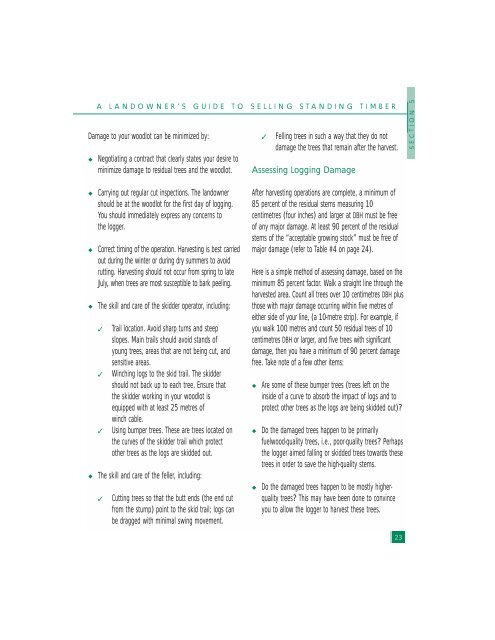A Landowner's Guide to Selling Standing Timber - the Ontario ...
A Landowner's Guide to Selling Standing Timber - the Ontario ...
A Landowner's Guide to Selling Standing Timber - the Ontario ...
You also want an ePaper? Increase the reach of your titles
YUMPU automatically turns print PDFs into web optimized ePapers that Google loves.
A LANDOWNER’S GUIDE TO SELLING STANDING TIMBERDamage <strong>to</strong> your woodlot can be minimized by:sNegotiating a contract that clearly states your desire <strong>to</strong>minimize damage <strong>to</strong> residual trees and <strong>the</strong> woodlot.yFelling trees in such a way that <strong>the</strong>y do notdamage <strong>the</strong> trees that remain after <strong>the</strong> harvest.Assessing Logging DamageSECTION 5ssssCarrying out regular cut inspections. The landownershould be at <strong>the</strong> woodlot for <strong>the</strong> first day of logging.You should immediately express any concerns <strong>to</strong><strong>the</strong> logger.Correct timing of <strong>the</strong> operation. Harvesting is best carriedout during <strong>the</strong> winter or during dry summers <strong>to</strong> avoidrutting. Harvesting should not occur from spring <strong>to</strong> lateJuly, when trees are most susceptible <strong>to</strong> bark peeling.The skill and care of <strong>the</strong> skidder opera<strong>to</strong>r, including:yyyTrail location. Avoid sharp turns and steepslopes. Main trails should avoid stands ofyoung trees, areas that are not being cut, andsensitive areas.Winching logs <strong>to</strong> <strong>the</strong> skid trail. The skiddershould not back up <strong>to</strong> each tree. Ensure that<strong>the</strong> skidder working in your woodlot isequipped with at least 25 metres ofwinch cable.Using bumper trees. These are trees located on<strong>the</strong> curves of <strong>the</strong> skidder trail which protec<strong>to</strong><strong>the</strong>r trees as <strong>the</strong> logs are skidded out.The skill and care of <strong>the</strong> feller, including:yCutting trees so that <strong>the</strong> butt ends (<strong>the</strong> end cutfrom <strong>the</strong> stump) point <strong>to</strong> <strong>the</strong> skid trail; logs canbe dragged with minimal swing movement.After harvesting operations are complete, a minimum of85 percent of <strong>the</strong> residual stems measuring 10centimetres (four inches) and larger at DBH must be freeof any major damage. At least 90 percent of <strong>the</strong> residualstems of <strong>the</strong> “acceptable growing s<strong>to</strong>ck” must be free ofmajor damage (refer <strong>to</strong> Table #4 on page 24).Here is a simple method of assessing damage, based on <strong>the</strong>minimum 85 percent fac<strong>to</strong>r. Walk a straight line through <strong>the</strong>harvested area. Count all trees over 10 centimetres DBH plusthose with major damage occurring within five metres ofei<strong>the</strong>r side of your line, (a 10-metre strip). For example, ifyou walk 100 metres and count 50 residual trees of 10centimetres DBH or larger, and five trees with significantdamage, <strong>the</strong>n you have a minimum of 90 percent damagefree. Take note of a few o<strong>the</strong>r items:sssAre some of <strong>the</strong>se bumper trees (trees left on <strong>the</strong>inside of a curve <strong>to</strong> absorb <strong>the</strong> impact of logs and <strong>to</strong>protect o<strong>the</strong>r trees as <strong>the</strong> logs are being skidded out)?Do <strong>the</strong> damaged trees happen <strong>to</strong> be primarilyfuelwood-quality trees, i.e., poor-quality trees? Perhaps<strong>the</strong> logger aimed falling or skidded trees <strong>to</strong>wards <strong>the</strong>setrees in order <strong>to</strong> save <strong>the</strong> high-quality stems.Do <strong>the</strong> damaged trees happen <strong>to</strong> be mostly higherqualitytrees? This may have been done <strong>to</strong> convinceyou <strong>to</strong> allow <strong>the</strong> logger <strong>to</strong> harvest <strong>the</strong>se trees.23
















